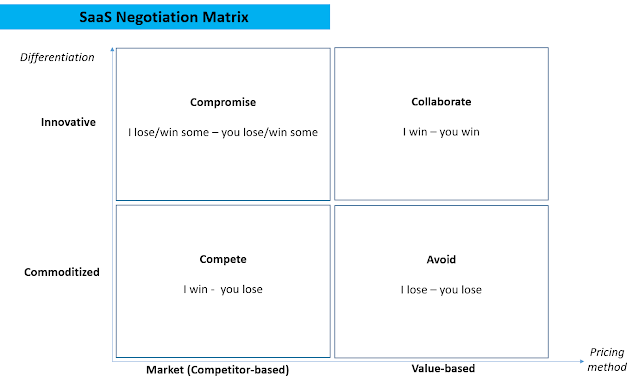Product Differentiation and Pricing-Based SaaS Negotiation Strategies
We often choose products or services based on their value or price. Value can be found in savings, efficiency, or competitive advantage.
On the other hand, price is a standard measure that indicates the competitive market for such a product. We select from a few available options by comparing their prices.
This post suggests we use a similar approach when purchasing SaaS (cloud software). We propose looking at SaaS from two angles: product differentiation and pricing method.
For commoditized SaaS products, we suggest subjecting them to fierce price competition via RFx or e-auctions where the pricing is competitor-based or avoiding value-based ones.
SaaS Negotiation Matrix
Among many available pricing methods, we selected the value- and competitor-based ones.
Competitor- and value-based pricing
Competitor-based pricing assumes that SaaS providers set their prices based on the ones charged by their competitors for similar products or services. This method allows SaaS businesses to remain competitive in the market while aligning their offerings' perceived value with others.Value-based pricing focuses on the price you believe customers are willing to pay based on the benefits your product or solution offers them. It depends on the strength of the benefits you can prove you offer to customers.
If you have clearly defined benefits that give you an advantage over your competitors, you can charge according to the value you offer customers. While this approach can prove profitable, it can discourage potential cost-conscious buyers.
If you have clearly defined benefits that give you an advantage over your competitors, you can charge according to the value you offer customers. While this approach can prove profitable, it can discourage potential cost-conscious buyers.
SaaS product differentiation
At the same time, the SaaS product can be highly differentiated due to its value, functionality, technological edge, or competitive advantage.
Otherwise, it can be commoditized, i.e., undifferentiated from similar offerings in the market. As a result, consumers often base their buying decisions primarily on price.
Using the Differentiation and Pricing method as the axis in our matrix, we will propose the applicable negotiation strategy for each quadrant.
For commoditized SaaS products, we suggest subjecting them to fierce price competition via RFx or e-auctions where the pricing is competitor-based or avoiding value-based ones.
For differentiated SaaS products, the idea is to compromise on the competitor-based ones (possibly, to our benefit, by looking at favorable price benchmarks) and collaborate on value-based ones (e.g., by negotiating value-share agreements.)
Such an approach should be more comprehensive than just the SaaS category. However, it's been inspired by relevant studies in the field of SaaS pricing.
P.S. If you appreciate hundreds of hours invested in researching and writing this blog, you can buy me a coffee or subscribe for the membership by following this link. Thank you!
To keep receiving new insights and research, please subscribe here.
More information on this and other exciting topics can be found in "The Technology Procurement Handbook." It represents 23 years of experience, billions of dollars worth of successful sourcing projects, and 1000s hours spent on research, analysis, and content creation for the most demanding professional readers.






Comments
Post a Comment